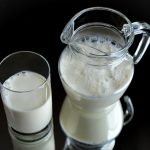Beta-lactoglobulin (BLG) is a major whey protein found in the milk of mammals, particularly in cow’s milk. It belongs to the lipocalin protein family and is one of the most abundant proteins in bovine milk, constituting about 50% of the total whey protein content. BLG plays essential roles in various biological processes, including nutrient transport, immunomodulation, and the formation of milk protein complexes. Understanding the chemistry and biochemistry of BLG is crucial for various applications in food science, nutrition, and biotechnology.
Beta-lactoglobulin is the major component in the whey proteins. We know that heat treatment denatures all these proteins and that it affects some more than others but beta-lactoglobulin is affected as any other (de Wit, 1984; 1990).
Chemical Structure
BLG is a globular protein composed of 162 amino acid residues with a molecular weight of approximately 18.3 kDa. It consists of a single polypeptide chain folded into a compact tertiary structure stabilized by intramolecular disulfide bonds and non-covalent interactions. BLG adopts a beta-barrel structure composed of nine anti-parallel beta-strands arranged in two beta-sheets, forming a hydrophobic ligand-binding pocket in the interior of the protein molecule.
The primary structure of BLG consists of alternating hydrophobic and hydrophilic amino acid residues, which contribute to its solubility in aqueous solutions such as milk. BLG contains several cysteine residues involved in the formation of disulfide bonds, which play a crucial role in stabilizing the protein’s tertiary structure and maintaining its functional integrity.
Functional Properties
BLG exhibits various functional properties that contribute to its biological and technological significance. One of the most notable features of BLG is its ability to bind hydrophobic ligands, such as fatty acids, retinol, and cholesterol, within its central cavity. This ligand-binding property allows BLG to function as a carrier protein for hydrophobic nutrients and bioactive compounds in milk, facilitating their transport and absorption in the gastrointestinal tract.
Moreover, BLG possesses excellent emulsifying and foaming properties, making it a valuable ingredient in food formulations such as dairy products, beverages, and emulsified sauces. The amphiphilic nature of BLG enables it to interact with both hydrophilic and hydrophobic components, stabilizing emulsions and foams and improving their texture and sensory attributes.
BLG also plays a role in the formation of protein complexes within milk, including the casein micelle, which is the primary structural component of milk. BLG interacts with other milk proteins, such as alpha-lactalbumin and caseins, through non-covalent interactions, contributing to the stability and functionality of milk protein aggregates.
Biochemical Properties
BLG exhibits unique biochemical properties that are influenced by its amino acid composition, structure, and interactions with other molecules. One of the key biochemical characteristics of BLG is its resistance to heat and enzymatic digestion. BLG remains stable under a wide range of temperature and pH conditions, allowing it to withstand processing techniques such as pasteurization and sterilization without significant denaturation or degradation.
Furthermore, BLG is highly resistant to proteolytic enzymes present in the digestive tract, such as pepsin and trypsin, which enables it to survive transit through the stomach and reach the small intestine intact. This resistance to digestion may have implications for allergic reactions to milk proteins, as intact BLG molecules can trigger immune responses in susceptible individuals.
BLG is also subject to various post-translational modifications, including glycosylation, phosphorylation, and oxidation, which can modulate its functional properties and biological activities. These modifications may occur naturally during milk secretion or processing or can be induced deliberately for specific applications in food and pharmaceutical industries.
Biological Functions
In addition to its role as a nutrient carrier and emulsifying agent, BLG has been implicated in various biological functions, including immunomodulation and allergenicity. BLG can interact with immune cells and receptors in the gastrointestinal tract, influencing immune responses and inflammatory processes. However, BLG is also recognized as a major allergen responsible for allergic reactions to cow’s milk in susceptible individuals, particularly infants and young children.
The allergenic properties of BLG are attributed to its ability to stimulate immune responses and produce specific IgE antibodies, leading to allergic symptoms such as skin rashes, respiratory distress, and gastrointestinal discomfort. Despite its allergenic potential, BLG is also being investigated as a potential candidate for oral immunotherapy to desensitize individuals with milk allergies.
Applications
BLG finds numerous applications in the food, pharmaceutical, and biotechnology industries due to its functional properties and biological activities. In the food industry, BLG is used as an ingredient in dairy products, infant formulas, sports nutrition supplements, and functional foods. Its emulsifying, foaming, and texturizing properties contribute to the sensory attributes and stability of food formulations.
Moreover, BLG has potential therapeutic applications in pharmaceuticals and nutraceuticals for the delivery of bioactive compounds and drug molecules. Its ability to bind hydrophobic ligands and interact with biological membranes makes BLG an attractive candidate for drug delivery systems and targeted therapies.
In biotechnology, BLG serves as a model protein for studying protein-ligand interactions, protein stability, and protein engineering techniques. Researchers utilize BLG as a scaffold for designing novel biomaterials, biosensors, and biocatalysts with tailored properties and functionalities.
Beta-lactoglobulin (BLG) is a versatile whey protein with unique chemical and biochemical properties that contribute to its functional significance in various biological processes and technological applications. Understanding the chemistry and biochemistry of BLG is essential for harnessing its potential in food science, nutrition, pharmaceuticals, and biotechnology, while also addressing challenges related to allergenicity and immunomodulation.
References
de Wit, J. N. (1984) Functional properties of whey proteins in food systems. Neth. Milk Dairy J. 38, pp. 71-89.
de Wit, J. N. (1990) Thermal stability and functionality of whey proteins. J. Dairy Sci. 73, pp. 3602-3612.
de Wit, J. N.; Klarenbeek, G. (1981) A differential scanning calorimetric study of the thermal behaviour of bovine alpha-lactoglobulin at temperatures up to 160 °C. J. Dairy Res. 48, pp. 293-302
Mulvihill, D. M.; Donovan, M. Whey proteins and their thermal denaturations: a review. Ir. J. Food Sci. Technol. 1987, 11, pp. 43-75
Verheul, M.; Pedersen, J. S.; Roefs, S. P. F. M.; de Kruif, C.G. (1998) Association behavior of native â-lactoglobulin. Biopolymers



Leave a Reply